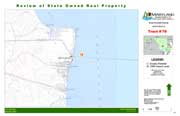 |
|||||||||||
|
Volume 13, Issue 3 ~ January 20 -26, 2005
|
|||||||||||
|
|
 PUBLIC PUBLICAre You and I Disappearing from Maryland's Public Spaces? story and photos by Carrie Steele This land is your land, this land is my land, this land was made for you and me. —Woody Guthrie It's a splotchy map, Maryland's excess public land, with odd-shaped, patterns splattered like red ink drips. We've seen the lands-for-sale stories and heard the uproar. But what's really at stake? With its sharp nose for news, the Baltimore Sun broke this story when a Public Information Act request from Maryland Department of Natural Resources uncovered an unpublicized list of surplus state properties. "People went crazy for a week," said Dick Lahn, director of the land conservation group String of Pearls, a non-profit that helps land trusts find people who want to put their land under conservation easements, so becoming a "pearl" of the Chesapeake. DNR manages nearly one-half million acres of public lands. In April 2003, Gov. Robert Ehrlich ordered that all those lands be accounted for. "I ordered an inventory of all State property to determine what holdings were worth the cost taxpayers paid to maintain them," Ehrlich wrote in a November public statement. In a 10-month-long review, biologists, scientists, planners and public land managers determined which lands paid their way — and which were getting a free ride. "Every department in the state was asked to take a look at its land," explained Gene Piotrowski, DNR's director for resource planning. His department conducted a review, too, and a team of professionals considered the land. "We looked at everything," he said. DNR listed nearly 2,900 acres of "excess property" thoughout the state, including lands in Anne Arundel and Calvert counties, that could potentially be sold. Actually selling any of those acres would require more review, eventually culminating in approval by the state Board of Public Works, which includes Gov. Robert Ehrlich as well as Comptroller William Donald Schaefer and Treasurer Nancy Kopp. "My administration has provided an innovative solution to one old problem: throwing money at property with limited value," Ehrlich explained. Touring Anne Arundel's Excess The idea of selling public lands enraged many Marylanders, who spoke out in news articles splashed across newspapers, letters to the editor, phone calls to elected representatives and talk on radio. One misty morning this month, that outcry drove a bright yellow school bus full of conservationist pilgrims to see with their own eyes lands named on the governor's list. "The land is like poker chips right now," said Lahn, who led the tour. "The land is looked at like a commodity, like a table or a  chair." chair."Lahn moved quickly and spritely, leading the conservations with his lime-green cap through the foggy woods. "No one ever sees the property," he said. "You can't make decisions without seeing the property." Lahn took his early January Excess Express tour on the road to show what's at stake and to inspire citizens to think. That's what happened as some dozen local environmentalists looked for themselves at the land parcels so highly publicized. Lahn handed out spiral-bound notebooks and disposable cameras to the group so they could better document what they saw. "It's amazing how they can just sell these lands," said Sierra Club activist Sue Youngs as she climbed aboard the bus to see to the surplussed acres of Patapsco State Park. Like Youngs, most were curious and skeptical. "There are reasons why all these properties were bought," Lahn said. Reasons range from conservation to science to acceptance of a gift of land. Now, Lahn is organizing their skepticism in a report to legislators and the governor. His major concerns are, first, the criteria for a land parcel to be declared excess, and, second, there should be more public input on what happens to these lands. Anne Arundel County's properties all fall on the headwaters of either the South River or the Patapsco River. With 642.5 acres on the excess list, Anne Arundel has the most to lose of Maryland's counties. Calvert County, on the other hand, has just 2.7 acres to lose. Maryland's Public Patchwork Over the past 100 years, through donations and acquisitions, the state has acquired a lot of land, and this donated land falls under DNR's management. "Most of the time, the property made sense to acquire," Piotrowski said. "But sometimes we get these pieces of land that are hard to get to." It's hard to manage plots of land that are isolated or detached by distance, roads or rivers. Some lands have poor access; others are landlocked with no potential for improvement. Management requires money, and land more difficult to manage takes more money. Being a "management challenge" by reason of isolation or detachment could exile a parcel to the list. Other lands become management challenges because of their neighbors, as people encroach and build on land they wish was theirs. More than half of the state's land was bought with federal restrictions and must be maintained for public use. If sold, these lands would have to be replaced with similar property.
"And in some cases, it doesn't make sense for us to have this tiny parcel of land that provides no public use," Piotrowski said. "Perhaps there's a county or municipality that would better use that property." As the government tries to make sense of the surplus lands, so do Marylanders. "It really upsets me when the point of view is what use should be made of the land," said Anne Pearson of the Alliance for Sustainable Communities during a visit to a parcel of excess land near BWI. "I'm excited that we have this type of land," said Sue Youngs of Anne Arundel County's Sierra Club upon seeing the Crownsville State Hospital parcel of excess land, "It's an oasis around I-97 and a wonderful home for wildlife." But, Youngs says, she worries about what might happen to the land. At Patapsco State Park Even if you're a regular visitor to Patapsco State Park, sprawling over parts of Anne Arundel, Baltimore, Carroll and Howard counties, it's unlikely that you've been to its 9.9-acre surplus parcel. Surrounded by private land and massive BWI parking lots, this parcel was transferred from the city of Baltimore in 1958. Separated from the main part of the park by the fast traffic lanes of Baltimore-Washington Parkway, the small lowlands literally helped build up the surrounding busy highway by giving up fill soil. "It's an interesting piece of land," Lahn said as the tour approached the site. "There's no access to it. We'll have to walk through private property." A short hike blazed through greenbrier and over sticks and stumps takes you to the spot. There, steep, wooded slopes dive into a wet, marshy area below. "If we'd hiked further into the parcel, we would see that there's an industrial park right next to the property," Lahn said. Youngs, from the Sierra Club, agreed that "it's definitely not virgin forest. But it's still natural and really neat," she said. Ed Wintermute, a loyal environmental volunteer said, "It doesn't cost them anything to let it sit here undisturbed." Regardless of what people say, this 9.9-acre parcel is likely to lessen Maryland's burden — and federal restrictions ensure that even after sale, the land must be maintained as open space or as recreational land. Though the State hasn't discussed possible transfers yet with anyone, according to DNR, this tiny tract may find a place in local government plans.
On a busy day at the Anne Arundel County Fair, bustling lines wait for garish rides, and thousands of families tour agricultural exhibits and interesting animals. Thrilled by popcorn and cotton candy, no one gives much thought to the 73.6 acres of gently rolling land under foot. The fairground is in Crownsville, but its waters flow to Broad Creek and continue on to the South River, according to South Riverkeeper Drew Koslow. This parcel was exiled to the state's excess list because, well, it is the county fair. Since 1952, the fairgrounds have been leased by the volunteer-run non-profit organization that coordinates the fair and a year-long calendar of events. In 1981, the state of Maryland acquired the land from private owners, intending to make it an eventual conservation area. Anne Arundel County Fair Inc., is two decades into a 99-year lease. "The state might have hoped it would connect to the Severn Run Natural Area somehow," speculated Piotrowski. It's now on the state's excess list because it's being leased. DNR doesn't have much to do with the land, Piotrowski said. Anne Arundel county would have better use of the parcel. Anne Arundel County Fair Inc.'s president, John Kozenski, believes that the fair would get the land if the state decides to sell it. But Kozenski doesn't think it will be sold. "The state pays no money on the fairgrounds," Kozenski said. "We're responsible for the mowing and maintenance, and all the buildings are ours." If the state were to break the lease, continued Kozenski, they would have to purchase the fair buildings. "If push came to shove, they'd transfer it to us. It would never be offered for public sale because of greenways in the area," Kozenski said.  At Crownsville State Hospital At Crownsville State HospitalAn amorphous and sprawling plot of land behind the old Crownsville State Hospital, this 559-acre parcel runs to the west along Interstate-97. It was transferred from the Department of Health and Mental Hygiene in 1992, because "it was thought that it was better that the DNR manage the land," Piotrowski said. All along, Anne Arundel County has had its eye on the property. County Executive Janet Owens isn't shy about her interest in acquiring the land for county green space. "We want that 500 acres west of I-97 to be turned over to the county," Owens told Anne Arundel County legislators of her '05-wish list in the General Assembly.
"There's a beaver pond with mature forest surrounding it," said Koslow as he motioned over Bacon Ridge Branch toward the 559 headwater acres. Other features deserve conservation, as well. When the bus tour disembarked onto the mist-shrouded land, tourists encountered row after row of graves of former hospital patients. A solitary number marked each flat headstone. With a conservation easement pending by the Maryland Environmental Trust, Lahn isn't worried about this land. "Nothing's going to happen to this property," he said. "But why is it on the list? It just gets people mad."  The state's prepared to part with Crownsville State Hospital Residual's mostly wooded headwaters of the South River because it's isolated, without easy road access. Anne Arundel County would, thereby, acquire more than 500 acres of open space. The state's prepared to part with Crownsville State Hospital Residual's mostly wooded headwaters of the South River because it's isolated, without easy road access. Anne Arundel County would, thereby, acquire more than 500 acres of open space.At Hallowing Point Back in 1973, Maryland purchased 1.3 acres at Hallowing Point in Calvert County to establish a research center on the Patuxent River. Just south of the Benedict Bridge, Hallowing Point Research Center first housed scientists from Chesapeake Biological Laboratory and later from PEPCO while they studied river water quality. The forgotten chalk-white building sits just above the river on a private residential lane, surrounded by shrubs and trees. "It's been vacant for a number of years," said Piotrowski, who didn't know of any restrictions on the 1.3 acre-plot. "It's a residential house, and it's not being used." If the land were declared excess, he said, local government could put dibs on the riverside parcel.  Along North Beach Bayfront Along North Beach BayfrontJust north of North Beach, a 1.4-acre parcel of beach and marsh buffers the Bay from Route 261. Across the road are acres of marshland and mudflats, fed by an ingress/egress waterway that cuts through the excess property. This small tidal stream allows flow from the Bay under the road to the wetland. North Beach Mayor Mark Frazer wants to keep this public Bayfront beach under state, county or municipal ownership for its rarity and ecological importance. Adjacent private neighbors have expressed interest in buying the property, but Frazer doesn't think that they'll succeed  . ."It's important that the title of this property not be transferred to private owners," Frazer said. Largely ignored, the wetland has degraded. For the past four years, restoration has been underway, led by the Army Corps of Engineers as part of a larger flood control project. "It was the opinion of the Corps that to control flooding, restoring the wetlands was important," Frazer said. If the state decides to excess the 1.4 Bayfront acres, Frazer has made no secret of his hopes that the deed will be transferred to the town. "I just saw DNR Secretary Ron Franks last week," Frazer said of his fellow dentist and classmate. "He's aware of the piece of property. I have no concerns at this point." Avoiding a Slippery Slope The excess lands issue has politicians and officials uneasy, too.
Singling out a controversial deal over 836 acres of state woodlands in St. Mary's County, Busch said, "the state was operating as a real estate agent, using Open Space funding with the idea of flipping it to an individual. That's wrong: it's like insider trading, to give one individual preferential treatment. "In the 1960s, Anne Arundel County and Baltimore County executives went to jail for such deals," the speaker warned. That unconsumated deal was a worst-case scenario, according to Busch. "Other public land could be considered for sale as it does have cost to the state," he allowed. "But it should be considered parcel by parcel under a fair legislative process." In this session of the General Assembly, Democrats will be seeking broader scrutiny on any sale of the excess lands. "We'll be trying to curtail the sale of public lands without due process, putting oversight in the hands of the legislature and not just the Board of Public Works," said Anne Arundel Del. Virginia Clagett, who is a member of the House Environmental Matters Committee. The Senate Budget and Taxation Committee is already holding hearings on what role lawmakers should play. Transferred or not, environmental money is pledged to stay with environmental investments.  "If there were any funds generated," said DNR's Piotrowski, "that would be an opportunity to recycle money back into land preservation funds to buy land that would make sense to own, like lands adjacent to bigger tracts for better public and conservation use." "If there were any funds generated," said DNR's Piotrowski, "that would be an opportunity to recycle money back into land preservation funds to buy land that would make sense to own, like lands adjacent to bigger tracts for better public and conservation use."Federal environmental restrictions would also require that revenue from the sale of many excess lands be reinvested in buying lands of the same type as were sold. "The list was disturbing when it came out," Koslow said. "But hearing that it might be kept as open space is encouraging." A List of Fear and Hope When public lands seem like poker chips, Marylanders worry that their natural heritage may be dealt away from their hands. "It's incredible for a management resource agency to call certain lands management challenges," Lahn said. "They need to change their attitude toward land and their policy on excess lands."  Though everyone may not be organizing bus tours or speaking out publicly like Lahn, many Marylanders feel protective of public open space. Since first public mention of the list in mid-autumn, the uproar has died down, but anxiety remains, surfacing in fo Though everyone may not be organizing bus tours or speaking out publicly like Lahn, many Marylanders feel protective of public open space. Since first public mention of the list in mid-autumn, the uproar has died down, but anxiety remains, surfacing in fo
Like Denise Breitburg, a scientist who once worked across the Patuxent from Hallowing Point Research Center, Marylanders feel these lands are their lands. "As a resident of Calvert County, where there's so little access to water, the notion of selling public property is outrageous," she said. Though anxieties run high, what we've found is that the list is just that: a list. For now. "Just because they're not doing anything right now, doesn't mean they won't do anything later," Lahn worried, echoing a common theme. Thus Marylanders want to know what's going on with their land through transparent goverment processes. "I hope they have some sort of public input," says South Riverkeeper Koslow. "If it's not open, then you don't know." |
||||||||||
|
© COPYRIGHT 2004 by New Bay Enterprises, Inc. All rights reserved. |





